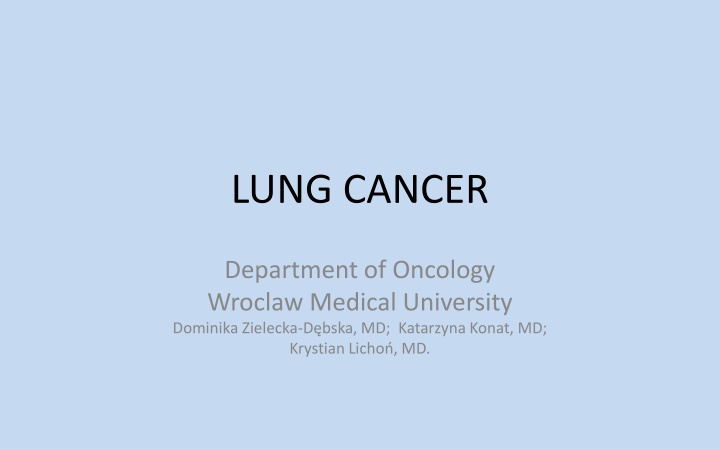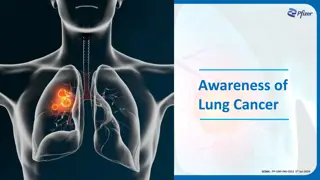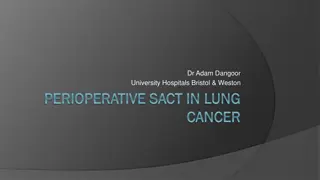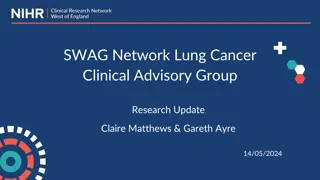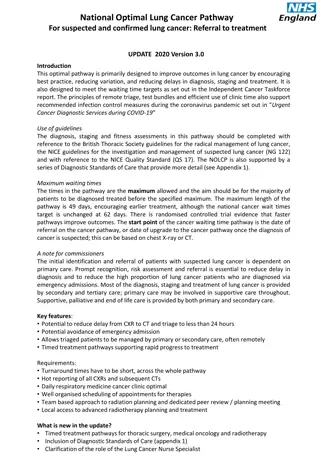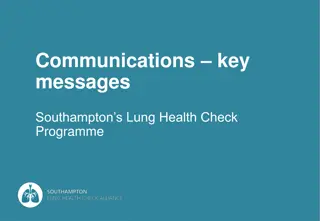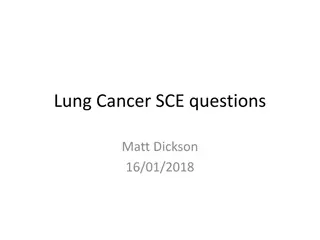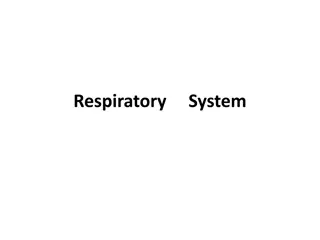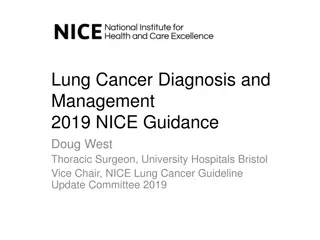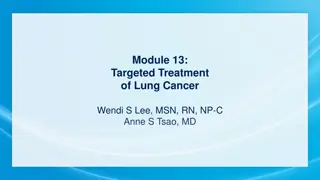LUNG CANCER
Lung cancer is a significant health concern in Poland, with a high mortality rate. Explore the epidemiology, screening methods, symptoms, and risk factors associated with this disease. Learn about the histological types, with a focus on non-small cell lung cancer and small cell lung cancer. Discover the 5As framework for smoking cessation and gain insights into the impact of smoking on lung cancer risk. Stay informed to promote early detection and prevention strategies.
Download Presentation

Please find below an Image/Link to download the presentation.
The content on the website is provided AS IS for your information and personal use only. It may not be sold, licensed, or shared on other websites without obtaining consent from the author.If you encounter any issues during the download, it is possible that the publisher has removed the file from their server.
You are allowed to download the files provided on this website for personal or commercial use, subject to the condition that they are used lawfully. All files are the property of their respective owners.
The content on the website is provided AS IS for your information and personal use only. It may not be sold, licensed, or shared on other websites without obtaining consent from the author.
E N D
Presentation Transcript
LUNG CANCER Department of Oncology Wroclaw Medical University Dominika Zielecka-D bska, MD; Katarzyna Konat, MD; Krystian Licho , MD.
Epidemiology Lung cancer in Poland in 2013: New cases Deaths Men 14609 15981 Women 6915 6647
Lung cancer in Poland in 2013 (men) Mortality Incidence Lung Lung 19% Prostate Prostate 26% 27% Skin Colon 31% Bladder Stomach Colon Bladder Rectum Pancreas 16% 3% Stomach Rectum 2% 3% 2% Kidney Kidney 3% 4% 8% Larynx Brain 4% 6% 8% Pancreas Larynx 4% 6% 7% 5% 7% Others Others 7% 6%
Lung cancer in Poland in 2013 (women) Incidence Mortality Breast Lung Lung Breast 16% 22% Skin Colon 30% 32% Endometrium Ovary Colon Pancreas 14% Ovary Stomach 9% Cervix Cervix Rectum Unknown origin 2% 8% 9% Thyroid Brain 3% 3% 6% 4% 3% Kidney Rectum 3% 4% 7% 5% 6% 5% 3% 6% Others Others
Screening Low-dose CT scans for high-risk group: Current or former smoker with a 30 or more pack-year smoking history 55-74 years of age No evidence of lung cancer Decreased the mortality rate from lung cancer by 20% (NLST).
Symptoms Cough, Dyspnoea, Chest pain, Hemoptysis, Hoarseness, Superior vena cava syndrome, Horner's syndrome, Superior sulcus tumor triad, Dysphagia, Pleural effusion, Shoulder pain, Postobstructive pneumonia. Weight loss, Weakness, Arthralgia, Increased body temperature, Paresthesia, Thrombosis, Paraneoplastic syndromes (hypercalcemia, hypertrophic pulmonary osteoarthropathy, gynecomastia, VIP diarrhea).
Risk factors 1. 2. 3. 4. Smoking tabacco, disease history (eg. COPD), previous cancer history, family history of lung cancer, exposure to radon, arsenic, chromium, asbestos, nickel, cadmium, beryllium, silica and diesel fumes. 5.
5As framework smoking cessation Ask Advice Assess Assist Arrange
Histological types 1. Non-small cell lung cancer Adenocarcinoma (40%) Squamous cell carcinoma (30%) Large cell carcinoma (10%) Carcinoid tumors (rare) 2. Small cell lung cancer (15%)
Biology non small cell lung cancer Adenocarcinoma tends to be peripherally located with high propensity to metastasize. Squamous cell carcinoma usually centrally located with lower propensity for brain metastasis. Large cell carcinoma peripherally located. High propensity to metastasize, especially to brain. Carcinoid tumors typical carcinoids rarely metastasize and are not associated with smoking, atypical carcinoids more frequentlymetastasize, have poorer prognosis and are associated with smoking.
Biology small cell lung cancer > 95% of cases are associated with a history of tabacco exposure. Rapidly growing. 10-15% patients present with brain metastases and two year incidence after chemoradiotherapy is 50-80%. The most common solid tumor associated with paraneoplastic syndromes.
Evaluation (1) 1. History (age, smoking history, previous cancer history, family history, occupational exposures, other lung disease, exposure to infectious agents, risk factors or history suggestive of infection, comorbidities), Physical examination (include performance status and weight loss), Chest X-ray in two projections (persistent cough, recurrent pneumonia, hemoptysis), Chest CT with contrast (gold standard after chest X-ray), Upper abdomen CT or USG (liver or adrenal metastasis), Bronchoscopy (always in the presence of hemoptysis), Pathologic evaluation (thoracentesis for pleural effusion, sputum cytology, bronchoscopy with biopsy or bronchial swab for central tumors, CT-guided biopsy for peripheral lesions, fine-needle aspiration, videothoracoscopy, mediastinoscopy, thoracotomy), 2. 3. 4. 5. 6. 7.
Examples of metastases in NSCLC Spine (note spinal cord compression) Spine and adrenal gland
Evaluation (2) 8. Complete blood count, platelets, 9. Chemistry profile (blood urea nitrogen, creatinine, liver function tests, alkaline phosphatase, LDH), 10. Pulmonary function tests (presurgical and preradiotherapy evaluation), 11. FDG PET/CT scan, 12. CT or MRI with contrast of brain (for non-squamous lung cancer with involved lymph nodes, all stage III-IV or for neurologic symptoms), 13. MRI of thoracic inlet for superior sulcus tumors.
Prognostic factors Stage of the disease, Performance status (KPS, WHO), Weight loss (> 10% over 6 months), Lactate dehydrogenase (SCLC), Pleural effusion, EGFR and KRAS mutations, ALK gene rearrangements (adenocarcinoma and NSCLC NOS).
Karnofsky Performance Status 100 Normal; no complaints, no evidence of disease 90 Able to carry on normal activity; minor signs or symptoms of disease 80 Normal activity with effort, some signs or symptoms of disease 70 Cares for self; unable to carry on normal activity or to do active work 60 Requires occasional assistance, but is able to care for most of his needs 50 Requires considerable assistance and frequent medical care 40 Disabled; requires special care and assistance 30 Severely disabled; hospital admission is indicated, but deast is not imminent 20 Very sick; hospital admission necessary; active support treatment necessary 10 Moribund; fatal process progressing rapidly 0 Dead
Lung cancer TNM T tumor size, location and invasion of adjacent structures, N location of metastases to regional lymph nodes, M presence of distant metastases.
LD and ED in small cell lung cancer Limidet-stage disease (LD) Stage I-III (T any, N any, M0) that can be safely treated with definitive radiation doses. Excludes T3-4 due to multiple lung nodules that are too extensive or have tumor/nodal volume that is too large to be encompased in a tolerable radiation plan. Extensive-stage disease (ED) Stage IV (T any, N any, M1a/b) or T3-4 due to multiple lung nodules that are too extensive or have tumor/nodal volume that is too large to be encompased in a tolerable radiation plan.
Lung cancer treatment Treatment of lung cancer depends on numerous factors (NSCLC/SCLC, clinical stage, performance status, comorbidities) and the decision should always be done by multidisciplinary team consisting of experienced thoracic surgeon, radiation oncologist, clinical oncologist, pathologist, pulmonologist and radiologist.
Surgery non small cell lung cancer Treatment of choice for patients with stage I, II and selected IIIA (without N2) is surgery. video assisted thoracic surgery (VATS) and minimally invasive surgery (robotic-assisted surgery), sublobar resections: segmentectomy or wedge resection, lobectomy and sleeve lobectomy with regional lymph node resection, pneumonectomy with regional lymph node resection. The objective is always to achive negative margin! (No role of cytoreductive surgery in definitive treatment). For patients with IIIA N2 disease and good response to neoadjuvant chemotherapy surgery may be considered.
Chemotherapy non small cell lung cancer concurrent with radiation therapy for IIIA and IIIB stage disease (or sequential before radiotherapy), concurrent with radiotherapy for positive surgical margin (or sequential before radiotherapy), before surgery for selected IIIA N2 disease, as palliative treatment. Platinum-based chemotherapy is the most effective. Examples of chemotherapy regimens for NSCLC: Cisplatin + etoposide/ vinblastine/ vinorelbine/ gemcitabine/ docetaxel/ pemetrexed, Carboplatin + pemetrexed/ paclitaxel.
Radiotherapy non small cell lung cancer Stereotactic body radiation therapy (SABR): stage I and selected node negative stage IIA for patients who are medically inoperable or who refuse to have surgery. Postoperative radiation therapy (PORT) with or after postoperative chemotherapy: for patients with positive surgical margins and postoperative N2 disease. Thoracic radiotherapy concurrent with chemotherapy (or sequential after chemotherapy): radical treatment for stages II-III. Definitive local therapy to isolated or limited metastatic sites (brain, lung, adrenal gland): for well-selected patients with good performance status who have also received radical therapy to the intrathoracic disease, Palliation or prevention of symptoms (pain, bleeding, obstruction).
SABR for cT1, cN0, cM0, NSCLC tumor in an elderly patient
Targeted therapies Targeted therapy uses agents targeting various molecular pathways. For the treatment of advanced NSCLC specific targeted therapies are available: bevacizumab recombinant monoclonal antibody that blocks the vascular endothelial growth factor (VEGF), erlotinib, gefitinib, afatinib small molecule thyrosine kinase inhibitors of epidermal growth factor receptors (EGFR), crizotinib small molecule inhibitor that shows benefit in a subset of NSCLC that is characterized by the EML4-ALK fusion oncogene (found in some relatively young, never or light smokers with adenocarcinoma), ceritinib small molecule inhibitor that targets ALK and IGF-1, alectinib small molecule inhibitor that targets ALK and RET.
Surgery small cell lung cancer Surgery is rarely used for SCLC. Patients with SCLC that is clinical stage I (T1-2, N0) after standard staging evaluation and ruling out occult nodal disease (mediastinoscopy or other surgical mediastinal staging) may be considered for surgical resection: lobectomy with mediastinal nodal dissection or sampling. Postoperative N0 chemotherapy, Postoperative N(+) chemoradiotherapy.
Chemotherapy - small cell lung cancer For all patients with SCLC, chemotherapy is an essential component of appropriate treatment: after surgical resection, with thoracic radiotherapy in LD, in ED (alone or combined with radiotherapy). Examples of chemotherapy regimens for SCLC: cisplatin and etoposide (LD, ED), carboplatin and etoposide (LD, ED), cisplatin and irinotecan (ED), carboplatin and irinotecan (ED).
Radiotherapy small cell lung cancer Radiotherapy is often used for the treatment od SCLC: Thoracic radiotherapy with concurrent chemotherapy in LD (or sequential after chemotherapy) as radical treatment. Thoracic radiotherapy after chemotherapy in ED consolidative treatment for selected patients. Prophylactic cranial irradiation (PCI) in patients with LD who have a good response to initial therapy and in patients with ED that has responded to systemic therapy. Whole brain radiation therapy (WBRT) for brain metastases. Palliative treatment.
Summary Lung cancer is very common and it is the leading cause of cancer deaths. Symptoms are nonspecific. The most important risk factor in smoking tabacco. Two different types of lung cancer are non small cell lung cancer (NSCLC) and small cell lung cancer (SCLC). Treatment may include surgery, chemotherapy, radiotherapy, targeted therapies and best supportive care depending on cancer type, disease stage, patient s performance status and other factors.
Literature Kordek R.: Onkologia. Podr cznik dla student w i lekarzy, wydanie trzecie. Via Medica, Gda sk 2007. Hansen E., Roach III M.: Handbook of Evidence-Based Radiatiom Oncology, second edition, Springer 2010. Krzakowski M., Jassem J.: Nowotwory p uca i op ucnej oraz r dpiersia, w Onkologia w Praktyce Klinicznej - Zalecenia post powania diagnostyczno- terapeutycznego w nowotworach z o liwych 2013 rok, tom I, Via Mecica, Gda sk 2013. National Comprehensive Cancer Network, NCCN Guidelines for treatment of cancer by site, Non-small lung cancer and Small call lung cancer access from 29.09.2016. Wojciechowska Urszula, Didkowska Joanna. Zachorowania i zgony na nowotwory z o liwe w Polsce. Krajowy Rejestr Nowotwor w, Centrum Onkologii - Instytut im. Marii Sk odowskiej - Curie. Dost pne na stronie http://onkologia.org.pl/raporty/ dost p z dnia 29.09.2016.
